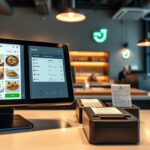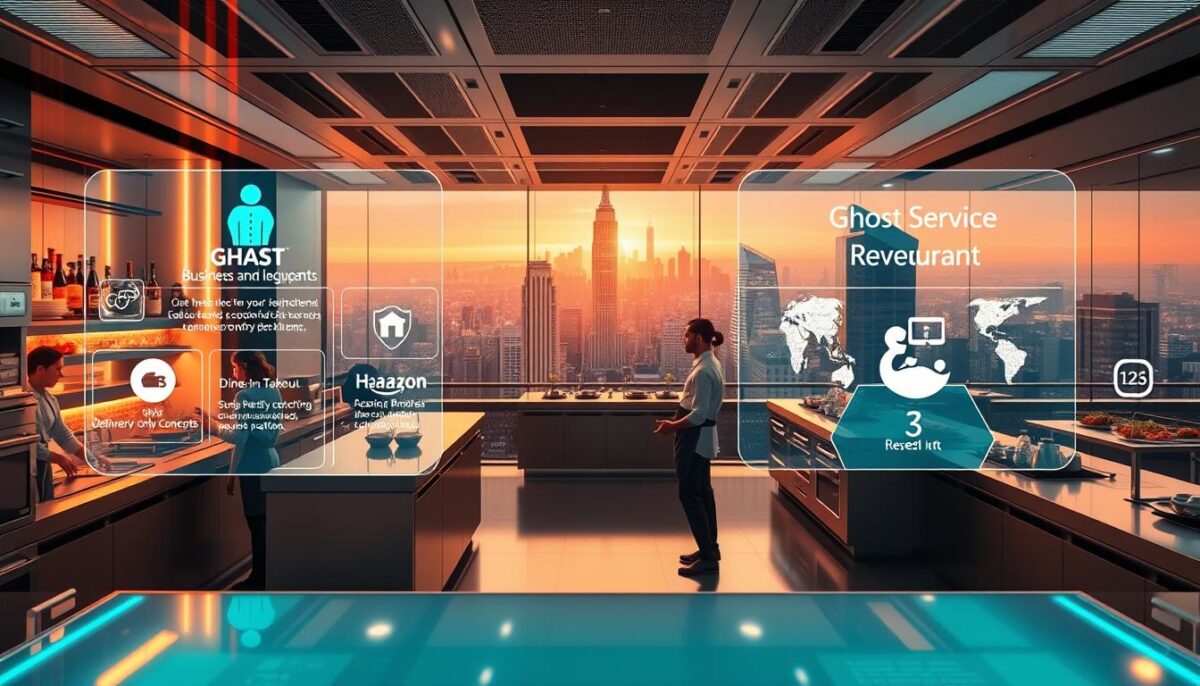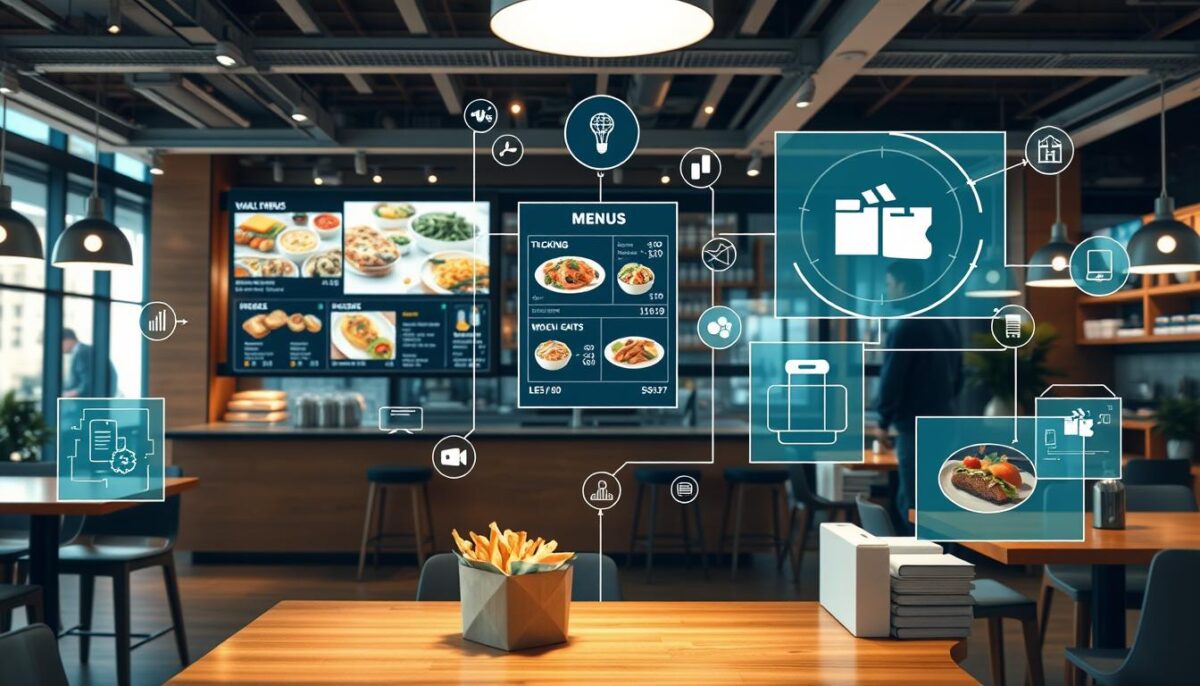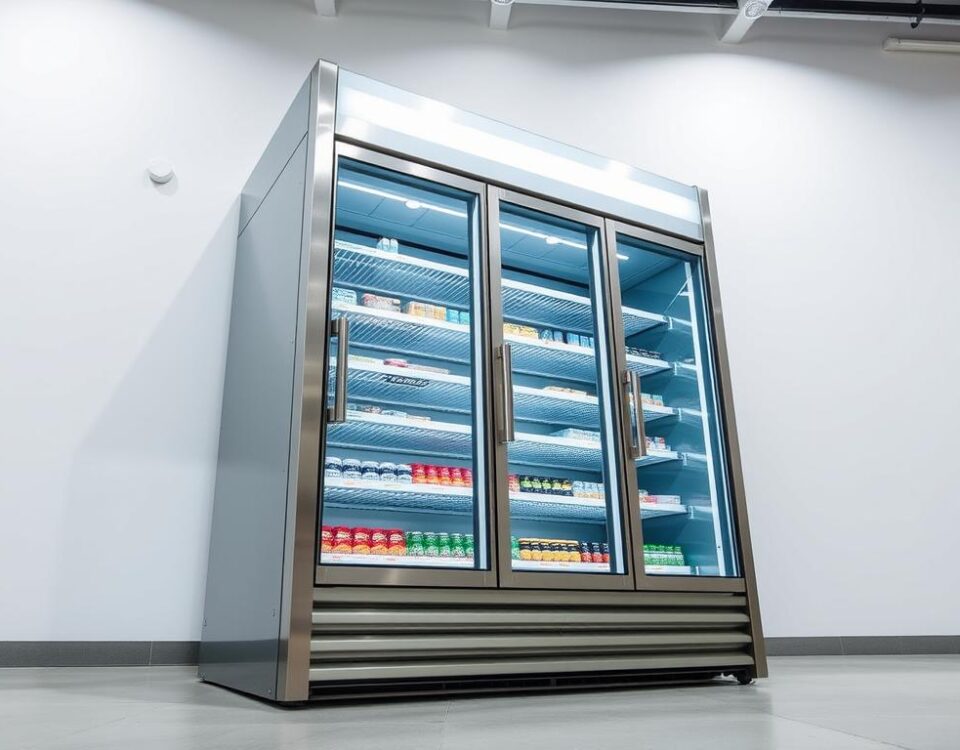
6 Hidden Secrets of Profitable Ghost Kitchen Operations
August 1, 2025
DoorDash + POS: Smart Integration Tactics That Save Time
August 2, 2025As a small restaurant owner, I’ve seen the rise of ghost kitchens and virtual restaurants transform the food service landscape. The cloud kitchen market was valued at US$32.460 billion in 2019 and is expected to grow at a CAGR of 12.28% to reach US$73.024 billion by 2026. This explosive growth is not just a trend; it’s a revolution that’s changing how we think about restaurants.
The global Virtual Restaurant & Ghost Kitchens Market size was valued at USD 65.30 billion in 2023 and is predicted to reach USD 155.54 billion by 2030. With this kind of growth, it’s clear that virtual restaurants are here to stay. But what does this mean for small operators looking to compete in 2026?
Key Takeaways
- The virtual restaurant market is expected to experience significant growth by 2026.
- Small operators can benefit from the economic advantages of virtual restaurants.
- Technological innovations are making virtual restaurants more accessible and efficient.
- Strategic partnerships can help small operators thrive in a competitive market.
- Regional opportunities vary, and small operators should identify the most promising areas for expansion.
The Evolution of Virtual Restaurants: From 2023 to 2026
As we approach 2026, the virtual restaurant landscape is undergoing a significant transformation. The virtual restaurant concept has gained immense popularity, driven by changing consumer behaviors and technological advancements.
Current Market Size and Growth Trajectory
The virtual restaurant market has experienced rapid expansion since 2023. According to recent data, the global virtual restaurant market size has grown substantially, with a significant increase in the number of virtual restaurants operating worldwide.
| Year | Market Size (Billion USD) | Growth Rate (%) |
|---|---|---|
| 2023 | 10 | 20 |
| 2024 | 12 | 25 |
| 2025 | 15 | 30 |
| 2026 | 18 | 35 |
Key Factors Driving the Virtual Restaurant Revolution
Several factors are driving the virtual restaurant revolution. The Covid-19 pandemic has accelerated the adoption of digital ordering platforms, making it easier for consumers to order food online. Additionally, rising real estate and labor costs have made traditional restaurant models increasingly challenging, paving the way for virtual concepts.
- Changing consumer behaviors, with 52% of customers considering food delivery essential.
- Increased technology adoption and digital ordering platforms.
- Rising real estate and labor costs.
- Changing urban landscapes and work-from-home trends.
The virtual restaurant industry is expected to continue its growth trajectory, driven by these key factors and the increasing demand for food delivery services.
Understanding Virtual Restaurants 2026: Market Projections

As we approach 2026, the virtual restaurant landscape is poised for significant transformation. The concept of virtual restaurants has evolved dramatically since its inception, and understanding its market projections is crucial for stakeholders.
Global Market Value and Growth Rate
The global virtual restaurant market is anticipated to experience substantial growth by 2026. Key players in the industry are driving this expansion through innovative business models and strategic partnerships. The market value is expected to increase significantly, with a compound annual growth rate (CAGR) that reflects the rising demand for food delivery services and the increasing popularity of cloud kitchens.
A company looking to enter this market must be prepared to adapt to changing consumer preferences and technological advancements. The virtual restaurant business model offers numerous opportunities for growth, particularly in regions with a high demand for food delivery.
North American Market Dominance and Opportunities
North America continues to dominate the global virtual restaurant market, driven by a large consumer base and a technically inclined population in the United States and Canada. The region’s market share is expected to remain significant throughout the forecast period.
For small operators in the United States and Canada, understanding the regional variations within the North American market is crucial. Identifying hotspots of virtual restaurant activity and untapped areas can provide valuable insights for businesses looking to carve out their niche. Additionally, being aware of the regulatory environments and consumer preferences specific to North American markets can help small operators develop successful virtual restaurant concepts.
Business Models Reshaping the Industry
The virtual restaurant landscape is rapidly evolving, driven by innovative business models that are reshaping the industry. As a result, small operators are presented with new opportunities and challenges in the market.

Standalone vs. Multi-brand Cloud Kitchens
Cloud kitchens are emerging as a dominant force in the virtual restaurant market. Standalone cloud kitchens focus on a single brand, allowing for specialized operations and menu offerings. In contrast, multi-brand cloud kitchens host multiple virtual restaurants under one roof, sharing resources and reducing costs. This model enables small operators to benefit from economies of scale and diversify their offerings.
Commissary and Aggregator Kitchens
Commissary kitchens serve as centralized facilities where food is prepared for multiple locations. This model allows for consistency and efficiency across various virtual restaurants. Aggregator kitchens, on the other hand, bring together multiple small operators under a single brand or platform, enhancing their collective market presence and operational capabilities.
Co-Working and Outsourced Cloud Kitchen Models
The co-working cloud kitchen model is gaining traction, allowing multiple small operators to share facilities, equipment, and sometimes even staff. This collaborative approach reduces overhead costs and fosters innovation among participants. Additionally, outsourced cloud kitchen models enable small operators to focus on menu development and marketing while leaving operational aspects to specialized partners. For instance, Kitchen United’s partnership with Kroger in August 2021 demonstrates the potential of collaborative models, combining aggressive expansion goals with customer demand for freshly prepared meals.
These emerging business models are transforming the virtual restaurant landscape, offering small operators new avenues for growth and success. By understanding and leveraging these models, companies can stay competitive in a rapidly evolving market.
Technology Innovations Powering Virtual Restaurants

Virtual restaurants are leveraging cutting-edge technology to optimize kitchen operations, menu engineering, and customer engagement. This technological revolution is crucial for small operators looking to stay competitive in a rapidly evolving market.
5G and Blockchain Applications in Food Delivery
The integration of 5G and blockchain technology is transforming the food delivery landscape. 5G enables faster data transfer, improving the efficiency of food delivery apps, while blockchain technology enhances supply chain transparency and food safety.
By leveraging these technologies, virtual restaurants can ensure seamless communication between consumers, delivery services, and kitchen operations, ultimately leading to improved customer satisfaction.
AI and Automation in Kitchen Operations
Artificial intelligence (AI) and automation are revolutionizing kitchen operations in virtual restaurants. AI-powered predictive ordering and inventory management enable operators to optimize stock levels and reduce waste.
Automation technologies, such as robotic kitchen assistants, are improving consistency and reducing labor costs. By implementing these technologies, small operators can scale their businesses more efficiently and maintain high-quality food production.
By embracing these technology innovations, virtual restaurant operators can gain a competitive edge, improve operational efficiency, and drive business growth.
Economic Advantages for Small Operators
In the rapidly evolving virtual restaurant landscape, small operators can expect to enjoy substantial economic benefits. The shift towards virtual restaurants is creating new opportunities for small businesses to thrive in a competitive market.
Reduced Overhead and Capital Requirements
One of the primary economic advantages for small operators is the reduction in overhead and capital requirements. Virtual restaurants, often operating out of ghost kitchens or shared kitchen spaces, eliminate the need for expensive real estate and dining areas. This reduction in overhead costs allows small operators to allocate more resources to menu development, marketing, and customer service. By leveraging cloud kitchens, small operators can easily invest in new menus and ingredients, effectively utilizing their resources.
Some key benefits include:
- Lower initial investment
- Reduced labor costs due to streamlined operations
- Minimal risk when testing new concepts or menu items
Operational Efficiencies and Resource Utilization
Virtual restaurants enable small operators to maximize productivity with minimal staff. By focusing on delivery and takeout, small operators can optimize their menu offerings and operating hours for maximum profitability. Data-driven decision making plays a crucial role in this process, allowing operators to adjust their strategies based on real-time consumer data.
- Menu engineering to reduce food costs and minimize waste
- Optimized pricing strategies based on demand
- Leveraging technology to create operational efficiencies
Challenges Small Operators Will Face in 2026
As virtual restaurants continue to proliferate, small operators in 2026 will face a myriad of challenges that could impact their survival. The virtual restaurant market is expected to become increasingly saturated, making it difficult for small companies to stand out.
Market Saturation and Competitive Pressures
The virtual restaurant industry will experience significant growth, leading to increased competition. Small operators will need to differentiate their offerings to attract and retain customers. Key strategies include developing unique menu items, leveraging social media, and focusing on exceptional customer service.
- Developing a niche or specialty cuisine
- Utilizing social media for brand awareness
- Implementing customer loyalty programs
Technology Vulnerabilities and Cybersecurity Concerns
As virtual restaurants rely heavily on technology, they become vulnerable to cybersecurity threats. Small operators must invest in robust cybersecurity measures to protect customer data and maintain trust. This includes securing online payment systems and protecting against data breaches.
Cybersecurity measures for small virtual restaurants include:
- Implementing encryption for customer data
- Regularly updating software and systems
- Training staff on cybersecurity best practices
Brand Building Without Physical Presence
Building a strong brand without a physical presence is a significant challenge for virtual restaurants. Small operators must focus on creating memorable brand experiences through packaging, digital interactions, and consistent quality. Storytelling and brand narrative play a crucial role in creating emotional connections with customers.

To build brand equity, small operators can leverage social media and digital marketing. By sharing their story and engaging with customers online, they can create a loyal customer base despite the lack of a physical location.
Regional Opportunities for Small Virtual Restaurant Operators
The virtual restaurant landscape is evolving, offering small operators a chance to expand into new regional markets. As the industry continues to grow, understanding the nuances of different regions will be crucial for success.
United States Market Landscape
The United States remains a significant market for virtual restaurants, with major cities like New York and Los Angeles leading the way. Cloud kitchens are becoming increasingly popular, allowing small operators to reduce overhead costs and focus on delivery. Companies like KFC are already leveraging this model to expand their reach.
| City | Market Potential | Key Players |
|---|---|---|
| New York | High | Uber Eats, GrubHub |
| Los Angeles | High | DoorDash, Postmates |
| Chicago | Medium | Uber Eats, GrubHub |
Emerging Markets in Asia-Pacific
The Asia-Pacific region is witnessing rapid growth in the virtual restaurant market, driven by countries like China and India. Swiggy’s ‘BrandWorks’ platform is a prime example of how companies are adapting to this trend by co-creating delivery brands with partners. The high disposable income and digital adoption in these markets create favorable conditions for virtual restaurants.

European and Middle Eastern Expansion Potential
In Europe, well-known brands like Punjab Grill and Kentucky Fried Chicken are establishing cloud kitchens to expand their presence. The Middle East is also seeing significant opportunities, with high demand for food delivery services. Understanding local consumer preferences and regulatory environments will be key to success in these regions.
By analyzing these regional opportunities, small virtual restaurant operators can develop targeted strategies to capitalize on emerging trends and expand their market share.
Conclusion: Preparing Your Small Operation for the Virtual Future
With the global Virtual Restaurant & Ghost Kitchens Market size projected to reach $155.54 billion by 2030, small operators must adapt to succeed. The virtual restaurant landscape is rapidly evolving, driven by technological advancements and changing consumer behaviors.
To position themselves for success, small operators should focus on developing a phased approach to virtual restaurant implementation. This involves assessing their readiness for the virtual space, identifying their competitive advantages, and minimizing risk while capturing growth opportunities.
Key trends shaping the virtual restaurant landscape in 2026 include the rise of ghost kitchens, increased adoption of technology, and shifting consumer preferences. Small operators must be prepared to innovate and adapt to stay competitive in this rapidly evolving market.
A successful strategy for small operators involves balancing short-term profitability with long-term strategic positioning in the virtual restaurant ecosystem. This requires a deep understanding of the business models reshaping the industry, including standalone and multi-brand cloud kitchens, commissary and aggregator kitchens, and co-working and outsourced cloud kitchen models.
By embracing the virtual restaurant model, small operators can build successful restaurant businesses with lower barriers to entry than ever before. As the company of the future, virtual restaurants offer unprecedented opportunities for growth and expansion. With the right strategy and a willingness to adapt, small operators can thrive in this exciting and rapidly evolving market.
In conclusion, the future of virtual restaurants is bright, and small operators who are prepared to innovate and adapt will be well-positioned for success in this rapidly growing market.
FAQ
What is the current market size of the global virtual restaurant industry?
The global market size is expected to experience significant growth, driven by increasing demand for food delivery and advancements in technology.
How will the cloud kitchen model impact small operators in the food industry?
The cloud kitchen model will provide small operators with reduced overhead costs and increased operational efficiencies, allowing them to compete with larger brands.
What role will technology innovations play in shaping the future of virtual restaurants?
Technology innovations, such as 5G and blockchain, will enhance the customer experience, improve operational efficiency, and enable new business models.
How will market saturation affect small virtual restaurant operators?
Market saturation will lead to increased competition, making it essential for small operators to differentiate their brands and develop effective marketing strategies.
What are the key benefits of strategic partnerships for small virtual restaurant operators?
Strategic partnerships will enable small operators to access new markets, improve their delivery capabilities, and enhance their overall competitiveness.
How will regional opportunities vary for small virtual restaurant operators?
Regional opportunities will vary, with the United States and Asia-Pacific regions offering significant growth potential due to their large consumer markets and increasing demand for food delivery.
What are the main challenges that small virtual restaurant operators will face in terms of brand building?
Small operators will need to develop effective brand building strategies despite the lack of a physical presence, leveraging digital marketing and social media to engage with customers.



